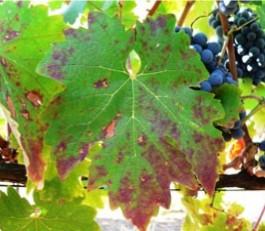Red Leaves in the Vineyard—Diagnosis, and Management
It is not uncommon to walk a vineyard row and find some vines with red leaves somewhere in the canopy. Red leaves can appear at any time in the growing season and are caused by many biotic (viruses, bacteria, and fungus) and abiotic (nutrient deficiencies, cold injury, and damage to root systems, etc.) stresses. Anything that can cause blockage or stress in the vascular system, where water and nutrients are transported, can result in the development of red leaves. Because of the variability in timing and pattern of appearance and the overlapping of the symptoms, it may be difficult to identify the cause based solely on visual symptoms. The best strategy is to get the vines tested for accurate diagnosis as soon as possible. The following are examples of abiotic and biotic stresses that are often associated with red leaves on grapevines.









